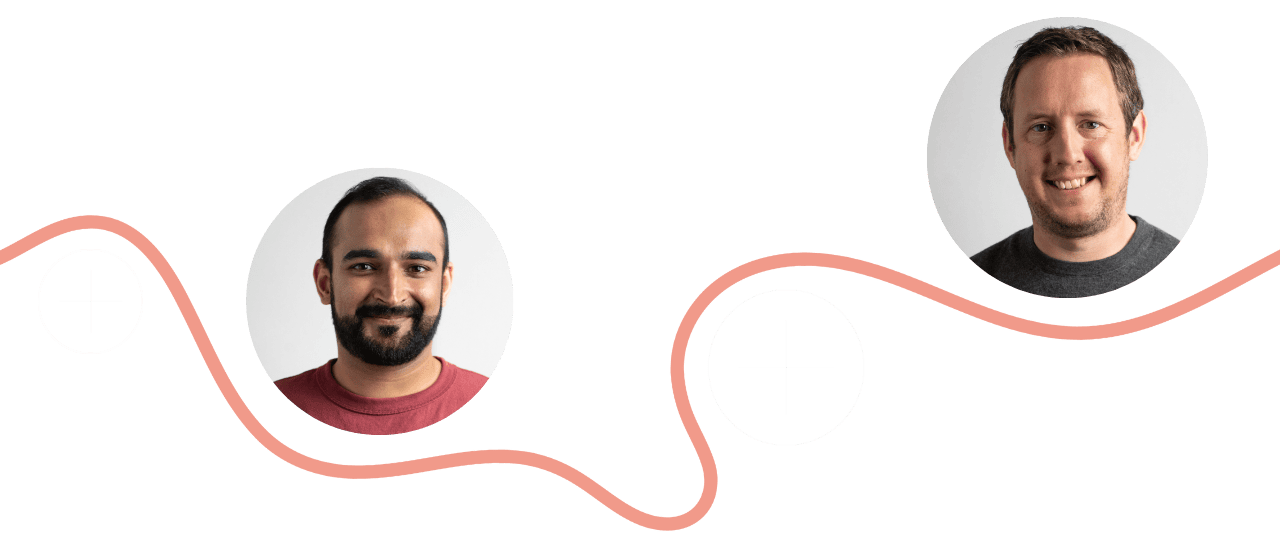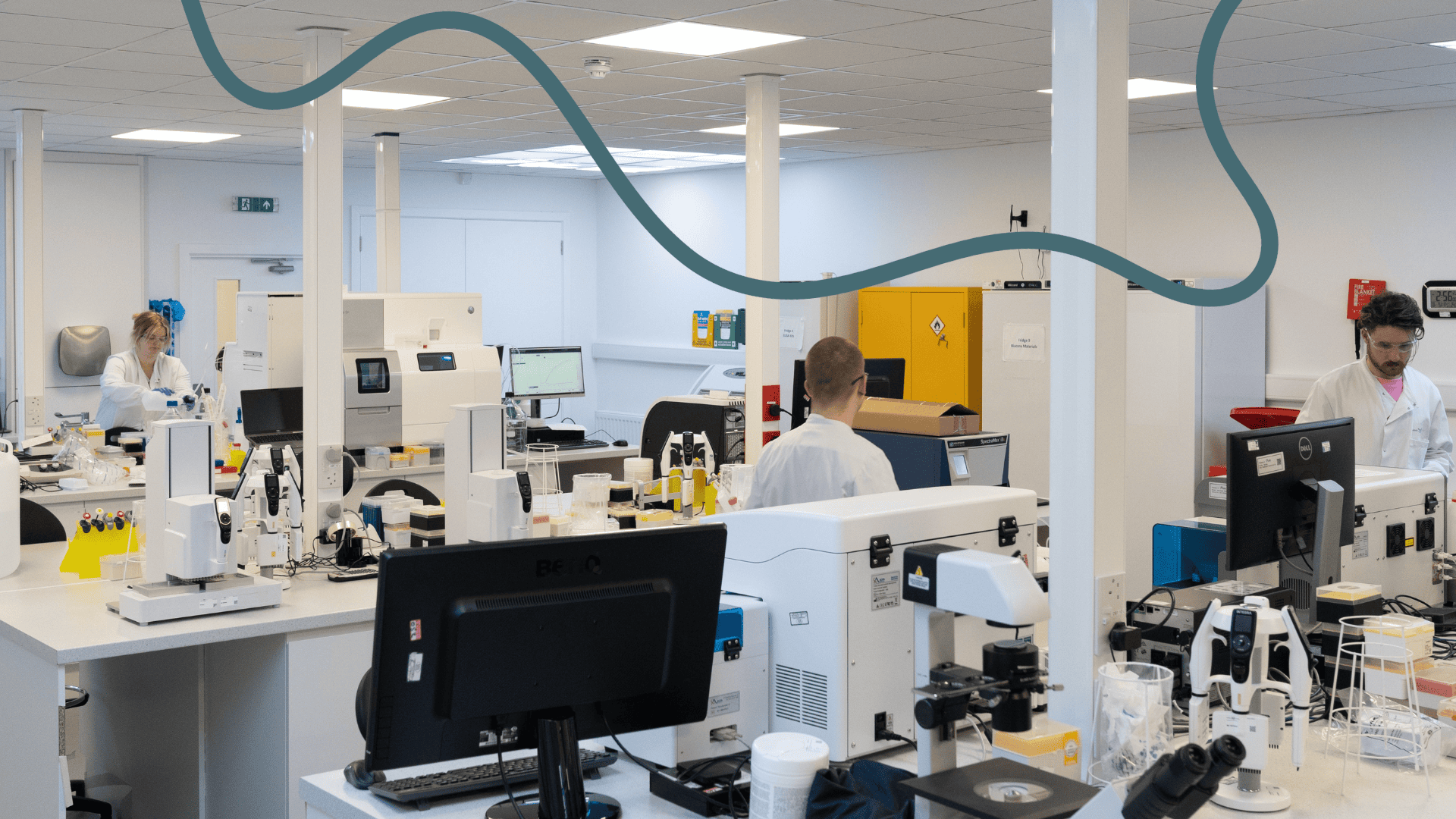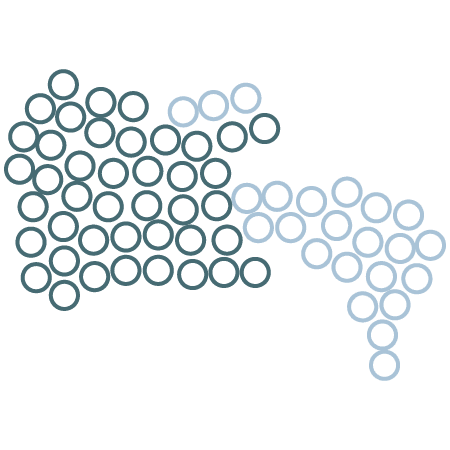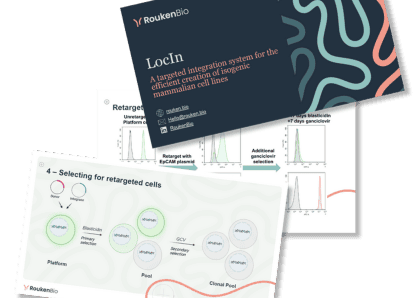Dynamic Cell Engineering for Future Drug Development
What’s the future of cell engineering? We caught up with our experts to talk cell engineering, RoukenBio’s trademark IndEx-2 technology, and to introduce our new targeted integration system – LocIn.

|
February 7, 2025
|
5 min read
Cells are the smallest units of life. They form the building blocks of all organisms; from a single-cell bacterium, to a multi-cellular towering giant redwood tree.
Our scientists use a toolbox of cell types to test the success of therapeutic candidates. So how does manipulating cells impact drug discovery?
We met Dr Timothy London (Scientific Director of Molecular Biology and Cell Engineering) and Dr Omar Kassaar (Senior Study Manager) to talk cell engineering, RoukenBio’s trademark IndEx-2 technology, and to introduce our new targeted integration system – LocIn.
Expert cell engineering services
Drug development depends on using a wide variety of cell types, including primary cells and continuous cell lines. These can be used directly, or engineered based on experimental goals.
Sourcing optimal cell types can be challenging due to ethical approvals, licensing requirements, and the availability of commercial lines with relevant targets. That’s where our Cell Engineering team comes in.
As well as providing an array of bioassay services, our experts can create custom cell lines to meet drug developers’ specific research needs. Tim and his team provide both tailored and ready-to-use cell solutions to support target validation, drug screening, and mechanistic studies.
“We started our Cell Engineering (CE) service to go into the assays we have in-house,” explains Omar.
“CE is a broader term than Cell Line Development, which reflects how we engineer a variety of cell line backgrounds to express or silence targets,” adds Tim. “As well as cell lines, we’ve also expanded to engineering primary cells.”

Inducible expression with IndEx-2
The team’s work culminated with the invention of IndEx-2, our trademark cell line system. IndEx-2’s USP is its ability to finely control the expression of not just one but two target antigens over a dynamic range. We’re the only service provider with this dual inducible technology.
“IndEx-2 allows the estimation of an antigen density threshold for the initiation of effector functions of a therapeutic,” explains Tim. “It’s the only system we’re aware of that allows the independent titratable expression of two different target antigens within the same cell lines. Most inducible systems are on/off; IndEx-2 allows the titration in expression of the target antigen.”
“Early adopters have given feedback that they want a granular level of control of titratability. It’s a strong USP,” adds Omar.
So, what was the idea behind IndEx-2?
“There was a gap in the market,” says Tim. “Drug developers looking at the effect of antigen density on efficacy and safety of therapeutics were using cancer cell lines with different levels of expression of target antigens, from different cell lines and tissue backgrounds.
A better system would be using a single cell background in which you could control the expression of the target antigen of interest (TAOI). Can we make a system like that? And if we can control the expression of one antigen, can we control the expression of two?”
Tackling on-target off-tumour toxicity
The technology can be implemented in many therapeutic areas, most promisingly in immuno-oncology.
Leveraging the immune system is an effective strategy in combating cancer. A major challenge is on-target off-tumour toxicities (OTOT), where target antigens overexpressed in cancerous tissues are also present in healthy cells and become a target for immunotherapies.
This severe side effect has been observed in CAR-T clinical trials in patients with solid tumours and presents a significant safety hurdle.
Cue IndEx-2.
“You can look at how your therapeutic responds to cells that express a healthy tissue level of the antigen,” says Tim, “and how it responds to a level of the target antigen that you’d find on cancer cells.
Overall, the system allows you to build a more complete picture of the activity profile of candidate therapeutics.”

Generating cell lines with LocIn
The team’s latest project is LocIn (pronounced loch-in, reflecting RoukenBio’s roots as a Scottish CRO). This aims to address the need for generating cell lines faster.
Currently, the timeline for generating a clonal overexpression cell line is 3-4 months. LocIn would shorten this by around 6 weeks. The targeted integration platform has accelerated generation of a clone in the CHO-K1 background, and Tim is hoping to have similar success in other cell backgrounds.
“LocIn will help with routine cell line generation platform in cell line backgrounds,” says Tim. “We’re near the point of launching this as a service for our customers.”
“It also offers targeted integration, hence the name “locus”, so we know the precise location of each integration and have the same integration across the cells,” says Omar. “For example, it would be useful for customers testing their molecule on the same receptor from different species.”
The hope is to combine LocIn with IndEx-2, accelerating cell line generation and ultimately therapeutic testing.
Omar continues, “they’re both independent technologies, but they’re complementary and can be used together or separately depending on what’s involved in the cell project.”
How rewarding is it for the team to work on novel systems that will hopefully benefit future drug discovery?
“When people initially get interested in a career in science, this is the type of thing they hope to be part of,” says Omar. “It’s rewarding to see our hard work generating a product that we can deliver to customers in their early drug development stages.”
“It’s always nice to see how the technology we’ve developed helps clients,” agrees Tim. “For example, we helped customers progress their lead molecule into Phase I clinical trials. I hope to see more examples of this in the future.”

The future of cell engineering
Where do the pair see CE developing with the advent of AI technology?
“AI holds broad potential in most fields,” says Omar. “For example, you can use the AlphaFold tool to accurately predict the structure of proteins. Structure and function are closely related, so AI is accelerating our understanding of that field. I wonder if in the future everything in CE will be done by AI!”
“We might eventually get to the point where, if we need an enzyme that performs a certain reaction, we understand enough to effectively code it at the amino acid level and it will fold into the enzyme with the desired function,” agrees Tim.
CE holds further potential in precision medicine.
“In the future, you could take cells from a patient and engineer them to reflect certain mutations or conditions,” explains Tim. “You could then use genetic engineering technology like CRISPR, which is currently used but will become bigger, to edit the patient’s cells to correct mutations. For example, with cystic fibrosis, repairing the mutation in the CFTR gene can reverse the disease completely.
In regenerative medicine, you could correct genetic defects to mend the regenerative capacity of cells. Cell engineering gene editing technology could eventually extend human lifespan.”
So, what is the future of the cell engineering field?
“There’s a possibility of creating universal donor cells that could alleviate things like graft vs. host disease,” hopes Tim. “So, we could have a bank of donor cells, for example T cells engineered to express CARs targeting tumour associated antigens, which can then be taken off the shelf and infused into patients. This could have a huge impact in the treatment of cancers.”
With two novel systems already generated, we’re excited to see what’s next for our Cell Engineering team.
Join our community of curious minds on LinkedIn
🗓️ Stay informed with our monthly scientific newsletter, published on LinkedIn on the last Wednesday of each month.
These editions bring you the latest in drug development breakthroughs, industry trends, and expert insights from the brilliant minds at RoukenBio.
Subscribe today on LinkedInIntroducing LocIn: RoukenBio's new targeted integration system
Learn how LocIn is accelerating cell line generation in our technical slide deck.
Access the presentation


